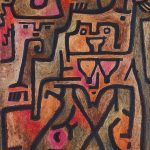
Vallotton was born into a conservative middle-class family in Lausanne, the third of four children. His father owned a pharmacy and later purchased a chocolate factory. His mother, Emma, was the daughter of a furniture craftsman. His family environment was warm but strict, in the Swiss Protestant tradition.
Beginning in 1875 he attended the Collège Cantonal, graduating with a degree in classical studies in 1882. He also began to attend the drawing classes of the painter Jean-Samson Guignard, normally reserved for most advanced students. He showed particular skill in close observation and realism. When he completed the course, he persuaded his parents to let him go to Paris to study art seriously.
In January 1882 he settled in Rue Jacob in the neighborhood of Saint-Germain-des-Pres and enrolled in Académie Julian, where he studied with the portrait painter Jules Joseph Lefebvre and the history painter Gustave Boulanger, and where he perfected his technical skills.
He spent many hours in the Louvre, and he greatly admired the works of Leonardo Da Vinci, Holbein, Dürer, and more modern painters, including Goya and Manet, and especially Ingres, whose works were models for Vallotton throughout his life.
In 1883, Vallotton’s father wrote to Lefebvre, questioning whether his son could make a living as a painter. Lefebre responded that the young Vallotton had the talent and ability to succeed. In the same year, Vallotton succeeded in the rigorous competition to enter the Ecole des Beaux-Arts but decided instead to remain at the Academie Julian, where his friends were. He also began to frequent the cafés and cabarets of Montmartre.
Very Prolific
In 1885 the methodical Vallotton began keeping a notebook, called his Livre de Raison, in which he listed all of his paintings, drawings, sculptures and prints. He kept the log his entire life. When he died, it listed one thousand seven hundred works.
In the same year he presented his first works at the Paris Salon; the Ingresque Portrait of Monsieur Ursenbach as well as his first painted self-portrait, which received an honorable mention. In the same year, he presented a painting at the Salon des beaux-arts in Geneva.
In 1887 Vallotton presented two portraits at the Salon, the Portrait de Félix Jasinski and Les Parents de l’artiste, which demonstrated his skill but also, by there extreme realism, departed from the traditions of portrait painting. They were severely criticized by his professor, Jules Lefebvre. Vallloton increasingly began to work outside of the Académie Julien.
He began to have financial difficulties; his father, whose firm was having its own financial problems, was unable to support him. his health also suffered; He came down with typhoid fever and then a bout of depression. In 1889 he returned to Zermatt Switzerland for several weeks to recover, and there painted several alpine landscapes. In 1889 he also met Hélene Chatenay, an employee in a Swiss factory or shop, who became his companion for ten years.
He presented several paintings at the Paris Universal Exposition of 1889, and at the same exposition he saw the gallery of Japanese prints, particularly works by Hokusai, which were to greatly influence his work. To earn his living, Vallotton worked as an art restorer for the gallery owner Henri Haro.
As An Art Critic
In 1890, he became an art critic for the Swiss newspaper La Gazette de Lausanne, writing some thirty articles about the Paris art world until 1897. In the same year, he made a European tour, visiting Berlin, Prague, and Venice. He was particularly impressed by Italy, and returned there frequently in later years.
In 1891, he showed his canvases for the last time in the official Salon des Artistes, and for the first time participated in the more avant-garde Salon des Independants, displaying six paintings. He began to receive commissions from Swiss art patrons. He experimented more frequently with various ways of making prints, using a technique called xylographie, in which became very adept.
He executed his first woodcut, a portrait of Paul Verlaine. His method was to make a very precise and detailed drawing, and then to simplify and simplify. His work was noticed by the writer and journalist Octave Uzanne, who published an article describing his work as “The renaissance of the woodcut. Source: Wikipedia.




